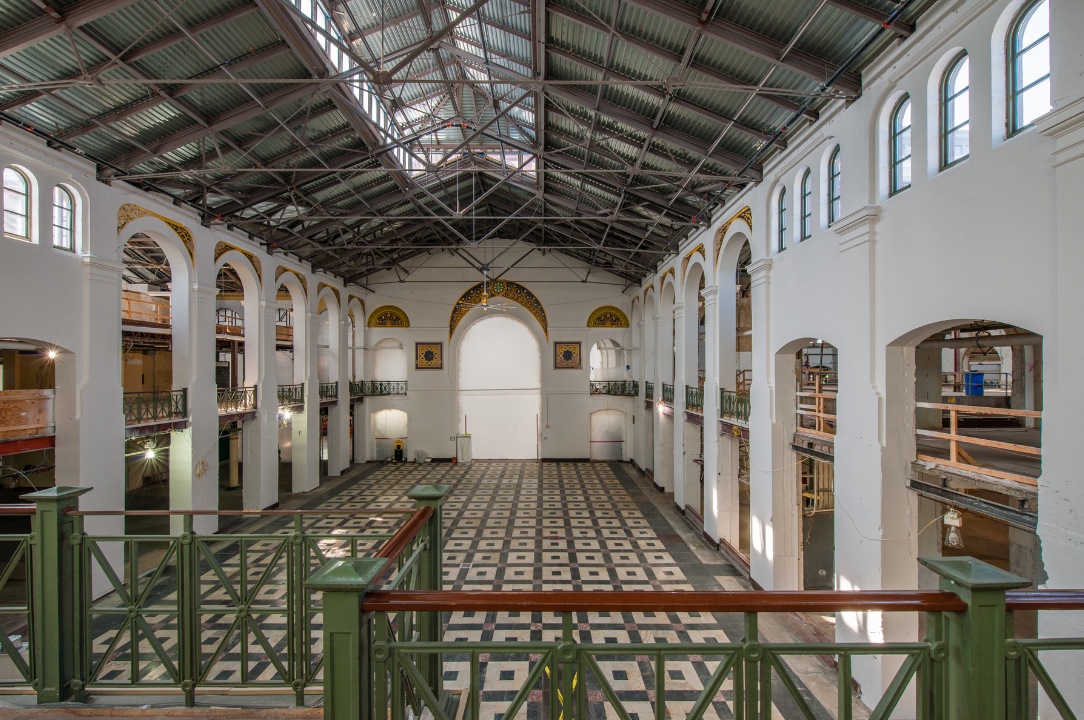Sometimes the best thing a Building Team can do for a client is to tell the client what not to do.
That dictum applies to the Smithsonian Institution’s Arts and Industries Building, which closed to the public in 2004, after 123 years of service. The National Historic Landmark (so designated in 1971) was being used for offices, not exhibitions; by 2006, it was in such bad shape that the National Trust for Historic Preservation named the AIB to its annual “Most Endangered Public Places” list.
SILVER AWARD
Smithsonian Institution Arts
& Industries building
Washington, D.C.Building Team
Submitting firm: SmithGroupJJR
(architect, MEP engineer)
Owner: Smithsonian Institution
JV partner architect: Ennead Architects
Structural engineer: McMullan & Associates
Fall arrest engineer: LJB
General contractor: Grunley ConstructionGeneral Information
Size: 120,000 sf
Construction cost: Confidential at owner’s request
Construction time: November 2010 to April 2014
Delivery method: Bid for general construction
Congress appropriated funds to revitalize and stabilize the structure, but only enough to restore the façade, replace the building’s signature roof, and upgrade the roof structure to meet code.
After removing decades’ worth of unfortunate additions to expose 17 historic interior spaces, the Building Team zoned in on the client’s key concern: Could the AIB be restored to its role as exposition/museum space?
The answer hinged on whether the building envelope could control the interior relative humidity to museum standards. The Building Team used computer modeling for moisture mitigation, plus studies of the HVAC systems, windows, and roof configuration and design, and concluded that it was impossible to retrofit the building to achieve the necessary humidity levels for the museum needs. Not exactly the answer the Smithsonian wanted to hear, but the right one.
That still left the enormous leaky roof, with its 46 surfaces and complex geometries. Finding new slate was easy: the quarry where the stuff came from for a 1980s re-roofing was still open. The team selected a matte-finished stainless steel to replace the deteriorated metal portion of the roof. For the first time, the roof had working gutters and downspouts to prevent leak-causing water valleys.
Structurally, with energy-efficient insulation being added to the roof structure, wrought iron roof trusses had to be tested, via computer modeling, to see if they could handle heavier snow loads. New high-strength steel trusses were designed to emulate the profiles of the existing wrought iron trusses.
Architecturally, exterior brick and stone were cleaned and replaced. Mortar was analyzed for color, composition, and strength. Interior stone, concrete, and terrazzo floors were mapped for cracks and preserved wherever possible. The original cast iron stairs and galleries were tested and retained. Exterior ground-floor window grilles were removed, repaired, and reinstalled. Students at Savannah (Ga.) Technical College fabricated 36 replacement spear points for the grilles.
The team went with energy-efficient aluminum windows with steel framing to meet security requirements. The window glazing is clear in offices, pavilions, and towers, but public spaces have an internal black/white dot film in the glazing that addresses visual light transmission and solar heat gain.
 In the North Hall, infill between piers and arches that compromised the historic spatial character was removed to open up the space and admit more light. Photo: Maxwell MacKenzie, Architectural Photographer.
In the North Hall, infill between piers and arches that compromised the historic spatial character was removed to open up the space and admit more light. Photo: Maxwell MacKenzie, Architectural Photographer.
Related Stories
Reconstruction Awards | Nov 16, 2016
Reconstruction Awards: Bay Area Metro Center
The structure’s 60,000-sf floor plates made the interior dark and foreboding, and BAHA wanted to improve working conditions for its employees and tenants.
Reconstruction Awards | Nov 16, 2016
Reconstruction Awards: Marilyn I. Walker School of Fine and Performing Arts, Brock University
The five-story brick-and-beam structure is an adaptive reuse of the Canada Hair Cloth Building, where coat linings and parachute silks were once made.
Reconstruction Awards | Nov 16, 2016
Reconstruction Awards: Marwen
Marwen currently offers 100 studio courses to 850 underserved students from 295 schools and 53 zip codes.
Reconstruction Awards | Nov 16, 2016
Reconstruction Awards: The Cigar Factory
The Cigar Factory was originally a cotton mill but became the home of the American Cigar Company in 1912.
Reconstruction Awards | Nov 16, 2016
Reconstruction Awards: St. Patrick's Cathedral
The cathedral, dedicated in 1879, sorely needed work.
Reconstruction Awards | Nov 15, 2016
Reconstruction Awards: Lovejoy Wharf
After demolishing the rotten wood wharf, Suffolk Construction (GC) built a new 30,000-sf landscaped quay, now known as Lovejoy Wharf.
Reconstruction Awards | Nov 15, 2016
Reconstruction Awards: KETV-7 Burlington Station
The 1898 Greek Revival train terminal, which was listed on the National Register of Historic Places in 1974, had been abandoned for nearly four decades.
Reconstruction Awards | Nov 14, 2016
Reconstruction Awards: The Gallery at the Three Arts Club
On the exterior of the building, masonry and terra cotta were revitalized, and ugly fire escapes on the south façade were removed.
Reconstruction Awards | Nov 14, 2016
Big-box store rescaled to serve as a preventive-care clinic
The hospital was attracted to the big box’s footprint: one level with wide spans between structural columns, which would facilitate a floor plan with open, flexible workspaces and modules that could incorporate labs, X-ray, ultrasound, pharmacy, and rehab therapy functions.
Reconstruction Awards | Nov 14, 2016
Fire-charred synagogue rises to renewed glory
The blaze left the 110-year-old synagogue a charred shell, its structural integrity severely compromised.

















